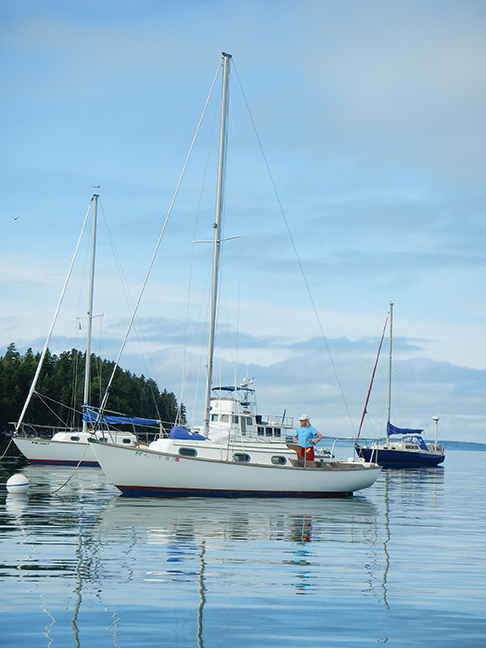Circumnavigators downsize to a smaller cruising boat and find themselves asking , “when is small too small?” (published March 2017)
- Looking back, Frenchman Bay in Downeast Maine was a fitting place for Tom and me to open the third leg in our cruising career. This was the part where we do the downsizing thing, and aside from one season in Sorrento Harbor on our Peterson 44, my decades of summer day sailing and overnighting here had been in 15 to 19-foot boats. I was used to plying these waters with minimal gear and a Cape Dory 25 seemed an extension of this experience.
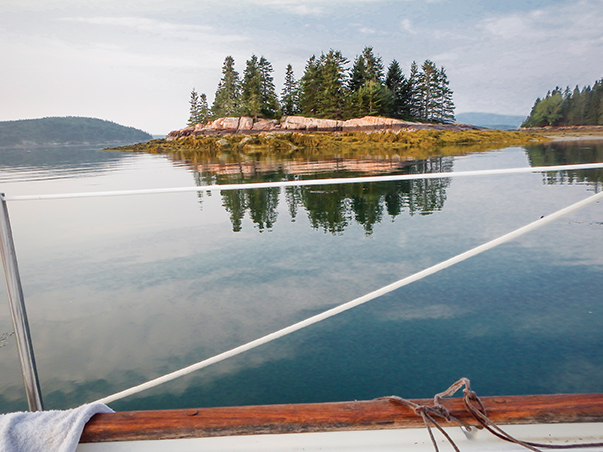 Besides, it was a joyous place for me and Blue Nun was already in Sorrento. We’d left Oddly Enough on the hard in Borneo to attend to shoreside business and within months of returning to the States, feeling rootless and boatless, purchased the Cape Dory 25 on the rebound. But instead of representing freedom, owning two boats stymied us and for several years we barely got on the water. Then, we sold Oddly Enough and everything changed. We finally planned a cruise on Blue Nun. The thought of really sailing again made me ecstatic, though “cruise” turned out to be a deceptive word.
Besides, it was a joyous place for me and Blue Nun was already in Sorrento. We’d left Oddly Enough on the hard in Borneo to attend to shoreside business and within months of returning to the States, feeling rootless and boatless, purchased the Cape Dory 25 on the rebound. But instead of representing freedom, owning two boats stymied us and for several years we barely got on the water. Then, we sold Oddly Enough and everything changed. We finally planned a cruise on Blue Nun. The thought of really sailing again made me ecstatic, though “cruise” turned out to be a deceptive word.We bought Blue Nun with visions of micro cruising with the perfect high-tech gear; every item of clothing, every tool and fitting would serve at least two purposes. Yet, for a four-day cruise at the end of August our gear consisted largely of three canvas bags recently purchased from the L.L. Bean outlet in Ellsworth, an old red ice chest that came with the boat, several grocery bags of food, a duffle of clothes, hastily purchased safety gear, a chart, Eldridge for rules of the road and tides, and a copy of A Cruising Guide to the Maine Coast. No GPS. An elderly handheld VHF radio. Two cell phones. An anchor light to hoist into the rigging. Two sleeping bags and pillows. A shower bag, 2 ½ gallons drinking water and a 5-gallon collapsible water jug. Instead of inflatable harnesses we had old-fashioned vests. I carried a sail repair kit and Tom had wrenches and screwdrivers.
Forget about planning; after 10 years of traveling on 44 feet of complicated (if wonderful) ocean-going sailboat, Blue Nun’s major appeal was that she was in great shape, needed just a bit of elbow grease to get going, and was small enough to be inherently simple. How much could you do to 25 feet?
The harbor was like silk when we rowed everything out. By 3 pm with the outboard going and the mainsail up leaving harbor was easy. We just uncleated the mooring pennant, tossed it overboard and waited for the bow to swing clear. No dock lines to untie, no sun covers to roll up. We cleared the channel between steep granite islands covered in dense stands of fir then out on Frenchman Bay I killed the 8-hp Honda, Tom rolled out the 110-percent genoa and we swung east on cat’s paw breezes.
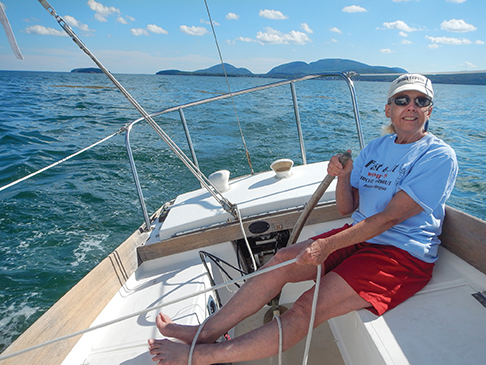
The relief of being away from land was huge. We picked up a mooring in smaller Flanders Bay and, once the boat was put to bed, opened potato chips and a bottle of Blue Nun from the ice box where it had stayed cold with two dozen frozen water bottles which would preserve our food and be slowly drunk as the days passed. Blue Nun’s first owners imported the sweet white wine and my grandmother drank it every night and lived to 101. Tom made baked beans with hot dogs in bright red casings that look thermonuclear but bring back fond memories of cookouts on the beaches here.
We watched the full moon rise and then it was time to roll out sleeping bags on the narrow salon berths, feet tucked under the sink and work table. The bunks didn’t leave much room for restless sleeping but the vee berth was tiny and had already been relegated to storage. We stayed up reading by the light of our Paperwhite Kindles. There were interior lights but the primitive electric system ran off one battery topped by by a single flexible solar panel.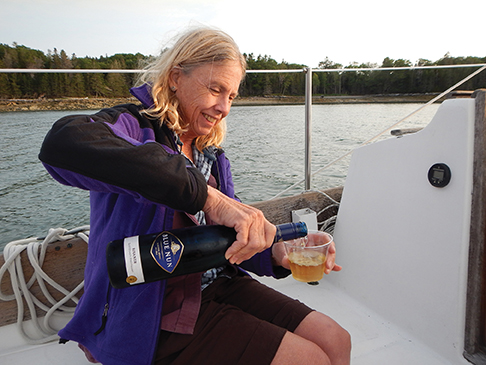 I woke early to gray light. As I emerged an inflatable boat pulled onto the island beach and a clammer climbed out in hip boots. He dug with his rake, filling wooden boxes in between talking on his cell phone. I began coffee in the cockpit on the portable single burner butane stove; I couldn’t envision setting it up below unless Tom dressed first and came on deck.
I woke early to gray light. As I emerged an inflatable boat pulled onto the island beach and a clammer climbed out in hip boots. He dug with his rake, filling wooden boxes in between talking on his cell phone. I began coffee in the cockpit on the portable single burner butane stove; I couldn’t envision setting it up below unless Tom dressed first and came on deck.When the wind came up mid-morning, we sailed five miles to Bar Harbor. The sky was milky blue and it was hot for Maine. Blue Nun made good time, four knots according to Tom’s phone GPS. Her bottom was clean and she was very tender, reminiscent of Kraken, our Gale Force 34 that in 10 knots of breeze buried her rail and then stayed stable as the wind built. Blue Nun scooted comfortably.
I know this horizon by heart. The cold bay is hemmed in by granite islands and bound to the south by the mountains of Mount Desert. It’s very different from tropical seas where I spent years swimming and sailing, diving and spearfishing. They say a cold ocean is fecund and we saw seals and small harbor porpoises that were much shyer than the bottlenose dolphins that cavorted around Oddly’s bow. Judging from the number of floats the bottom must be crawling with lobsters.
Fifteen years ago, we sailed Oddly Enough past Mount Desert and across this water to Sorrento in a full-blown Northeast gale. Today, when the lunchtime wind died we barely had steerage against a steady stream of tour boats and ferries.It didn’t take long to realize how limiting our propulsion was. August in Maine has unreliable wind and we had no history with Blue Nun’s 8-hp Honda outboard to know whether it was dependable and how much fuel it used in various conditions. The uncertainty condemned us to drifting around Frenchman Bay on light shifting breezes.
Cruising east or west along the coast required rounding unforgiving headlands in the Gulf of Maine with shelter far between. We left Sorrento with a three-gallon tank; it could be a lot, it could be a little. I like the challenge of navigating under sail in light winds but a problem with drifting in Maine is the lobster pots waiting to catch a propeller. In the entrance to Stave Island Harbor, where we would anchor for the night, the floats were thick as grass. On came the outboard a half-mile before I would have liked.
The anchorage just inside an unnamed granite islet had been recommended for shallow draft, and we only drew three feet. The depth sounder showed 15 feet but our battery was not keeping a charge and when we turned off the engine, the sounder went out too. We were a quarter into ebb tide and the depth would drop another eight feet by late evening. We carried a portable fish finder from Oddly Enough as a backup.
As the tide ebbed the current changed, setting us broadside to a swell curving in from the bay. A line of sharp boulders grew out from Stave Island off our bow and worry rumbled in my stomach, reminiscent of the nagging anxiety over the last year on Oddly Enough when I rarely relaxed and took on faith that an anchorage would be fine. Too much experience can be a curse. My only consolation was that a Cape Dory is like an overgrown keel daysailer and I could sail her anywhere.
Solar time told me happy hour had arrived but Tom was in Blue Nun’s tiny cabin so I waited to go below until he emerged. I took a blessed few minutes in shelter then poured wine and passed up bowls of chips. We sat on improvised cockpit cushions and watched the lobstermen returning home with their catch. Two people kayaked up to Stave, built a huge bonfire and camped for the night.
The evening’s entertainment was killing flies. I swatted ineffectually with a rolled up towel until I wrapped a plastic spatula in rigging tape and swatted briskly away, building up a litter of black bodies in the cockpit corners.Another beautiful, still morning in Maine. I crawled out of the confining sleeping quarters as a file of lobster boats droned by. In their wake was a loon call and response. When I looked over the side, grass waved back at me. By the time I’d made coffee the sun penetrating the water showed rocks and mud very close below us. One visitor to these islands woke to find the anchor sitting out of water on a rock. This bottom was too close and personal.
We planned to sail to a campground that serves as the municipal harbor for Lamoine Beach and where we might find a way to get to land. It had gradually dawned on us that our decision to leave Blue Whimple, a 9-foot roto-molded plastic tender, on the mooring stranded us on Blue Nun unless we stopped in a harbor with water taxi service. We couldn’t tow the rectangular plastic boat, and Blue Nun’s foredeck is too small for stowing an inflatable. Any dinghy of reasonable size would be at least a third as long as the Cape Dory, but deflating and stowing a good boat with floorboards in the V-berth every time we moved would be difficult and take up precious storage space.
Tom called the harbormaster. “Do you have a guest mooring available?”
“Haven’t got around to settin’ it up yet,” he said. This being now September, it seemed odd. Oh well.
We pulled up the anchor in what seemed to be a rising breeze but it wasn’t even enough to tack into the bay. On came the engine to get us out where the lobster pickup floats streamed steadily north on the tide. We drifted at a knot or so, circling the edge of Frenchman Bay along with kelp, seagulls, terns, porpoises and seals.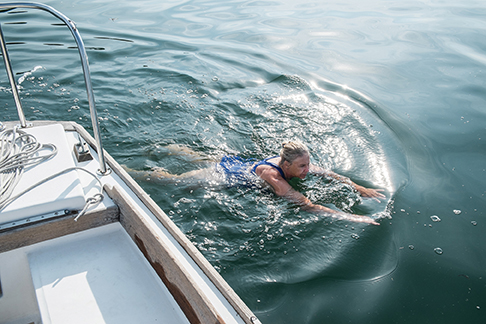 The current took us west then sucked us back toward Flanders Bay in the big tidal chute. At the last minute a prolonged gust drove us past the danger point. Tom put together cold cuts and carrot sticks and we drank lemonade mixed from powder into thawing water bottles. Then he retreated below feeling sun-struck.
The current took us west then sucked us back toward Flanders Bay in the big tidal chute. At the last minute a prolonged gust drove us past the danger point. Tom put together cold cuts and carrot sticks and we drank lemonade mixed from powder into thawing water bottles. Then he retreated below feeling sun-struck.By mid-afternoon we’d drifted to the entrance to Sullivan Harbor and anchored under sail behind Bean Island, a conservancy property that guards the exit from the bay. Grazing sheep once kept small meadows open but the sheep are gone and now it’s all treed granite. The north shore makes an inverted bowl shelving to sticky mud with 10 to 15 feet at low water; very sheltered under prevailing southerly winds. The forecast for the night however called for light northerly winds. Only an unfamiliar anchorage a couple miles up harbor offered shelter from it. I felt comfortable with the decision to stay, having anchored here many times.
The day was still warm. I had not been off the boat for three days and was determined to swim even though the sea was 55°. We got the sun shower hung on the boom and the rickety boarding ladder over the side and I gingerly tossed myself into dark green water. It felt like pins and needles on my arms as I made five circuits of Blue Nun.
-
I swarmed out and had just gone to change when a mast drifted by and a boat took up a mooring 20 yards away. Someone played a ukulele and the clouds looked painted on. Tom made canned chicken a la king supplemented with turkey lunchmeat over rice medley with more cauliflower. Our water bottles were still keeping things cold in this northern water. Seals growling on a nearby ledge made us laugh. At sunset when the guests next door left, the anchorage was bathed in silence. No wind generator, no electronic beeps. A low-lying mist had settled along shore but as it grew dark this disappeared.
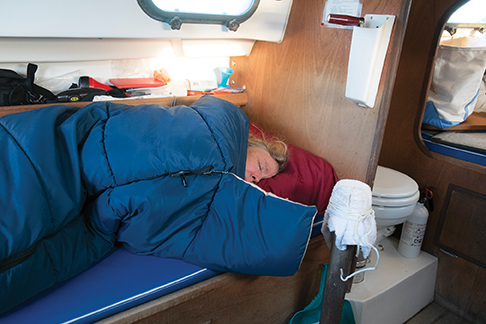 “Going to bed,” I announced. “So early?” I nodded. “Sun’s gone. No light.”
“Going to bed,” I announced. “So early?” I nodded. “Sun’s gone. No light.”I made 10 pages before sleep overtook me. I reached across the space of the salon passageway and locked hands with Tom, partner of my adventures, and was asleep within minutes.
-
Before midnight the boat suddenly swung amid the sound of rising wind, different and unfamiliar on Blue Nun. I tried to ignore the noises but anxiety had long legs for me and I needed to know what direction it blew from. As I emerged into the cockpit the wind was northerly as predicted but higher, more like 15 knots, blowing directly down the harbor so our stern was to the island and kicking up a short chop. The moored boat was a bit close but our battery-powered anchor light glowed cheerily. The stronger wind overruled the current and we bounced and bucked but didn’t roll and the anchor was holding.
I crawled into my bunk and shot out again to rescue the boarding ladder and towels, then to uselessly corral banging halyards. The boat rolled under my weight as I moved around, something Oddly Enough would never have done. It blew on for a while then subsided and the seas went down along with my heart rate. After a couple more bursts calm prevailed, and when I next woke the world was refreshed.
We picked up the anchor after coffee and by the time we reached Sorrento the wind was shifting and dying. Gulls roosting in Blue Whimple had released large splats of gray-white muck. They’d had a go at the town dock too. It made for a messy gear transfer but I didn’t care. It was great to be back after a cruise, to feel the familiar sense of accomplishment and, in the shower later, a slight roll when I closed my eyes.
That night we deconstructed the cruise and agreed that having a boat we can’t live on makes little sense. Look at all the marinas and driveways where boats sit unused for years on end while their people lead lives elsewhere. Blue Nun is a pretty boat, and when Tom checked the fuel tank we realized we could have motored for much longer distances, but she is not big enough to do what we want. We don’t need 44 feet, but something in the 35 to 39-foot range could do quite nicely for new cruising adventures.
Ann Hoffner and her partner Tom have been out cruIsing for two decades. Anne has written many cruising tales for Blue Water Sailing over the years.















